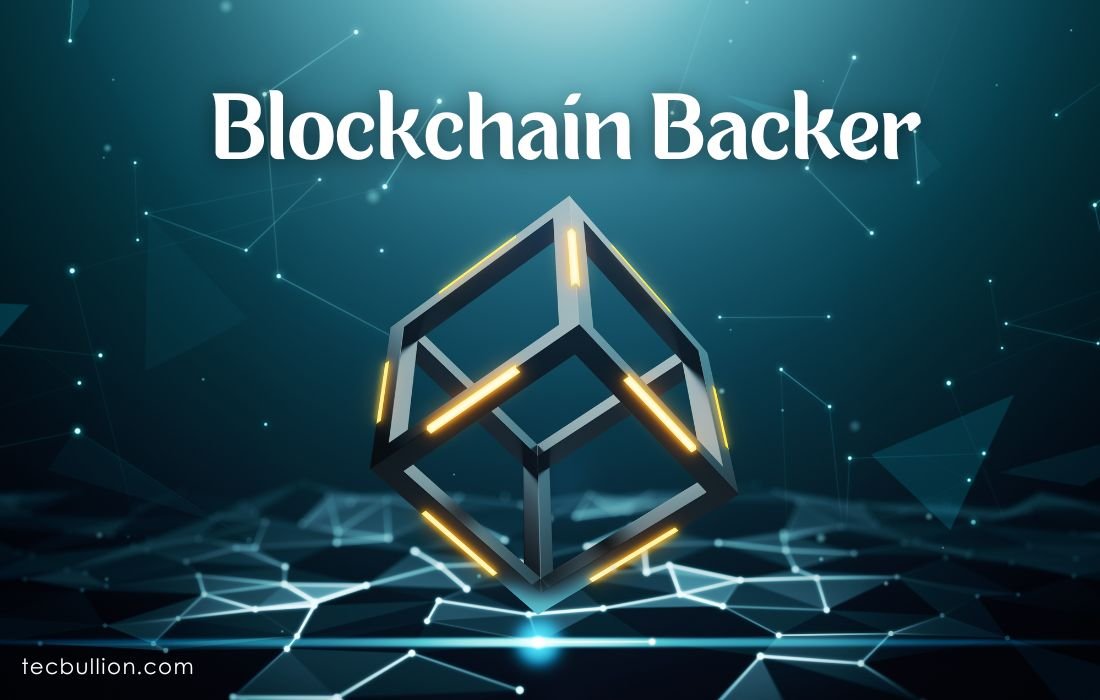As you navigate the ever-evolving landscape of the virtual era, you could have encountered the time period “blockchain” with growing frequency. You’ve questioned approximately its ability to impact your industry or non-public price range. As a blockchain backer, you apprehend the transformative electricity of this modern era. This guide will equip you with the information and insights needed to include blockchain skills completely. From understanding its fundamental standards to exploring real-world packages, you will discover how blockchain is reshaping how we behave, which behave inions, store information, and construct and agree with the virtual age. Put together to unencumber the blockchain’s capacity and function yourself at the vanguard of this technological revolution.
What is Blockchain Backer?
Blockchain technology is a revolutionary digital ledger system that has gained significant attention as a blockchain backer in recent years. This innovative approach to data management and transaction processing offers a range of benefits across various industries.
The Basics of Blockchain
At its centre, blockchain is a disbursed, decentralized, and public digital ledger that transactions information through a community of computer systems. In contrast to conventional databases, blockchain stores records in cryptographically connected blocks, growing an immutable chain of records.
Every block consists of some transactions, and when a new transaction occurs, it is delivered to every participant’s ledger. The decentralized nature ensures that no single entity controls the whole community, making it enormously proof against manipulation or fraud.
Key Features and Benefits
Blockchain technology offers several advantages that make it an attractive solution for various applications:
- Increased Security: The cryptographic links between blocks and the distributed nature of the network make blockchain highly secure and resistant to tampering.
- Improved Accuracy: Blockchain reduces the potential for human error in record-keeping by eliminating the need for manual verification.
- Enhanced Efficiency: Blockchain can significantly increase efficiency by eliminating intermediaries and automating verification processes.
- Transparency: All transactions on a public blockchain are visible to network participants, promoting accountability and trust.
Applications Beyond Cryptocurrency
While blockchain is often associated with cryptocurrencies like Bitcoin, its potential extends beyond digital currencies. As a versatile technology, blockchain has applications in various sectors, including:
- Supply chain management
- Healthcare data management
- Voting systems
- Real estate transactions
- Digital identity verification
As a blockchain backer, it is important to remember that this era continues to adapt, with new variations and use instances rising frequently. Blockchain’s potential to transform industries and streamline strategies makes it an interesting field for innovators and corporations alike.
The History and Evolution of Blockchain

Early Foundations
The roots of blockchain generation stretch back to the early 1990s when researchers Stuart Haber and W. Scott Stornetta first envisioned a cryptographically secured chain of blocks. Their goal became to create a gadget for time-stamping digital documents, laying the foundation for what might eventually become the blockchain we know today. In 2004, computer scientist Hal Finney introduced a machine known as “Reusable proof of labour,” which helped address the double-spending hassle in virtual cash.
The Birth of Bitcoin
The true revolution started in 2008 when an anonymous figure, Satoshi Nakamoto, published the whitepaper “Bitcoin: A Peer-to-Peer electronic cash gadget.” This seminal work introduced the idea of decentralized virtual forex constructed on blockchain generation. The launch of Bitcoin in 2009 marked the birth of the first practical blockchain application, ushering in a brand new era of digital finance.
Beyond Cryptocurrency
While synonymous with Bitcoin, blockchain generation soon began to demonstrate its potential past virtual currencies. The year 2014 marked a major turning point because the technology entered its “Blockchain 2. zero” section. This evolution saw the launch of Ethereum, a platform that introduced smart contracts decentralized applications (dApps), massively increasing the opportunities for blockchain generation.
The Blockchain Backer Era
As blockchain generation matured, it attracted interest from various industries beyond finance. The position of the blockchain backer became increasingly essential, with individual organizations championing the era’s potential revolution in sectors, including supply chain management, healthcare, and voting systems. This growing aid has been crucial in using blockchain’s evolution and adoption throughout numerous fields.
Major Components of Blockchain Networks
As a blockchain backer, understanding the elements that make up these modern systems is important. Let’s explore the primary components that shape the spine of blockchain technology.
Nodes and Network Architecture
at the coronary heart of every blockchain community lies its allotted structure. Nodes, which might be computers that hold the blockchain ledger, shape the foundation of this machine. Those nodes may be categorized as nodes, which store a replica of the blockchain, and lightweight nodes, which handiest preserve crucial information. They devise a robust peer-to-peer (P2P) network that allows direct transactions without intermediaries.
The Distributed Ledger
The ledger is the digital database that records all transactions within the blockchain. As a blockchain backer, you’ll encounter three types of ledgers:
- Public ledgers: Open and accessible to all participants
- Distributed ledgers: Maintained collectively by network nodes
- DecentralizDecentralizedperated without central control
Cryptographic Elements
Blockchain security is based heavily on cryptographic techniques. Hashing, a method that generates fixed-length outputs from information of any size, plays a critical role in maintaining the integrity of the blockchain. Another important element is nonce, a random number used to make transactions extra secure and to task miners during the block advent procedure.
Consensus Mechanisms and Smart Contracts
Consensus mechanisms, consisting of evidence of Stake (PoS) and evidence of work (PoW), ensure that every node agrees at the blockchain country. These protocols are vital for maintaining the community’s protection and authenticity. Smart contracts—self-executing packages that automatically enforce settlement terms—have become a quintessential part of many blockchain networks, enabling various decentralized blockchain Consensus Models.
The Foundation of Decentralized Trust
On the coronary heart of the blockchain era lies a central component enabling the decentralization of characteristics without a government: consensus mechanisms. As a blockchain backer, understanding those fashions is essential for how these structures preserve integrity and protection. Consensus mechanisms are the programming and approaches utilized in utilized systems to obtain dispensed agreement about the ledger’s state or information set.
Popular Consensus Models

Proof of Work (PoW)
PoW is the most extensively used consensus version, popularized popularized coin. In this gadget, miners compete to solve complicated cryptographic puzzles to validate transactions and upload new blocks to the blockchain. While rather comfortable and decentralized, it faces scalability challenges.
Proof of Stake (PoS)
PoS allocates block proposal responsibilities based on the number of cryptocurrency tokens held. This model is more energy-green than PoW but may additionally sacrifice a few degrees of decentralization. The recent transitions to PoS have brought this model into the spotlight.
Delegated Proof of Stake (DPoS)
DPoS is a variation of PoS in which users elect “witnesses” to validate transactions on their behalf. This model provides stepped-forward scalability and energy efficiency but introduces a level of semi-centralization of the Blockchain Trilemma.
The mission for blockchain backers and builders is to address the “bl—chain trilemma” – achieving—security, sdecentralizationntralizationusly. Researchers are exploring AI/ML-enabled consensus mechanisms to tackle, which will probably revolutionize networks’ operation.
As the blockchain environment evolves, knowledge of consensus models becomes increasingly crucial for everyone seeking to gain or develop blockchain initiatives. Every model offers specific trade-offs, and the choice depends on the particular wishes of the software and community.
Advantages and Disadvantages of Blockchain
As a blockchain backer, it is vital to recognize this technology’s strengths and barriers. This will allow us to explore the important blessings and capacity drawbacks of blockchain implementation.
Unparalleled Security and Transparency
One of the number one benefits of blockchain generation is its sturdy safety functions. According to Forbes, blockchain’s immutability makes it extraordinarily tough to tamper with recorded records, ensuring their integrity. This feature is particularly valuable for industries coping with sensitive data or financial transactions.
Furthermore, blockchain’s decentralizdecentralizedmotes transparency. As a blockchain backer, you will admire that community members can affirm statistics independently, fostering consideration among individuals. This transparency also creates an irreversible audit trail, ensuring clean traceability of transactions and modifications.
Efficiency and Cost Reduction
Blockchain technology has the potential to streamline operations and reduce expenses by eliminating intermediaries. As Finance Strategists mention, this will lead to quicker, more efficient transactions across diverse industries, from supply chain control to economic offerings.
Scalability and Performance Challenges
Notwithstanding its advantages, the blockchain era faces a few hurdles. One enormous assignment is scalability. GeeksforGeeks points out that the fixed block length can restrict transaction processing speeds, doubtlessly inflicting delays during high-volume intervals.
Moreover, the consensus mechanisms used in blockchain networks can cause slower performance compared to traditional databases. This trade-off between security and speed is an ongoing area of improvement for blockchain backers and researchers.
Implementation Costs and Complexity
While blockchain offers long-term financial savings, the initial implementation can be expensive and complex. As highlighted by using CFTE, businesses have to cautiously plan and execute their blockchain techniques to maximize and reduce drawbacks. This complexity can be a barrier to large adoption, mainly for smaller organizations that are fairly regulated industries.
As a blockchain backer, knowing the benefits and downsides is important for making informed choices about implementing this transformative era. By weighing the pros and cons, you can better navigate the evolving panorama of blockchain and harness its full potential.
Blockchain Use Cases Across Industries
As a blockchain backer, you’re likely aware of the technology’s potential to revolutionirevolutionizectors. Let’s explore some of the most promising applications across different industries.
Financial Services
The financial region needs to be faster to include blockchain technology. In step with ConsenSys, blockchain permits less difficult, cheaper, and quicker access to capital while lowering obstacles to issuance. It is also streamlining settlement, clearing, and compliance methods. DecentralizDecentralizedeFi) is a top instance, transferring from conventional centralized centralized to see-to-peer finance built on structures like Ethereum.
Supply Chain Management
Blockchain is reworking supply chain operations by providing exceptional transparency and traceability. As pronounced via Stanford University, businesses like Maersk have carried out blockchain to streamline logistics, increase transparency, and enhance efficiency. This technology permits quit-to-give-up visibility in delivery strategies, ensuring authenticity and decreasing fraud.
Healthcare and Life Sciences
Within the healthcare area, blockchain is revolutionizing management. In step with Krusche & agency, blockchain secures and decentralizes health information, patient consent, and drug monitoring. This improves information sharing while maintaining strict privacy and safety standards, and in the long run, enhances patient care and research competencies.
Digital Identity and Intellectual Property
Blockchain’s encryption and pseudonymity functions are ideal for defensive personal records and virtual belongings. Stanford College notes that blockchain provides a tamper-proof approach for recording and preserving the possession of virtual belongings like paintings and innovative works. This has substantial implications for highbrow belonging rights management in the digital age.
As a blockchain backer, you will find those use instances compelling proof of the technology’s transformative capability throughout industries. From finance to healthcare, delivery chain to digital rights, blockchain is a versatile and effective device for innovation and efficiency.
The Future of Blockchain – Where It’s Headed
As we see in advance, the future of blockchain technology appears increasingly promising and transformative. The global blockchain market is projected to attain an amazing $825. Ninety-three billion by 2032, signalling an incredible increase and adoption across diverse sectors.

Decentralized Finance (DeFi) Revolution
One of the most thrilling tendencies is the upward push of DecentralizDecentralizedeFi). This revolutionary monetary system leverages blockchain to bypass traditional banking, imparting greater transparency and fee efficiency in peer-to-peer transactions. As a blockchain backer, you’ll witness DeFi’s persevered enlargement as more customers, groups, or even governments recognize the importance of democratizing blockchain integration with emerging technologies.
The convergence of blockchain with other cutting-edge technologies is set to unlock new possibilities:
- Internet of Things (IoT): Blockchain integration with IoT will enable secure, decentralized access for smart devices and cities, revolutionizing our interaction with our environment.
- Artificial Intelligence (AI): The synergy between blockchain and AI promises to enhance security, scalability, and data integrity for AI-powered systems, paving the way for more robust and trustworthy applications.
Blockchain-as-a-Service (BaaS) and Enterprise Adoption
Blockchain-as-a-service services are simplifying blockchain adoption for groups across industries. This trend will boost employer integration, permitting businesses to harness blockchain’s advantages without the complexity of constructing and preserving their personal infrastructure. As a blockchain backer, you may see multiplied implementation in finance, healthcare, and supply chain control, using efficiency and transparency.
Blockchain Trends and Statistics
As a blockchain backer, it is important to stay knowledgeable about the latest trends and statistics. The blockchain panorama is evolving swiftly, with considerable growth projected in the coming years.
Market Growth and Adoption
the global blockchain marketplace is experiencing explosive growth. Consistent with Statista, the marketplace fee is predicted to surge from $7.four billion in 2022 to a staggering $ ninety-four billion by 2027, growing at a compound annual increase fee (CAGR) of 66.2%. This super growth underscores the growing adoption of blockchain generation throughout diverse industries.
Despite this increase, agency adoption of blockchain has remained low. Only around 10% of worldwide corporations have applied the technology, with the banking sector conserving the largest proportion of the blockchain market value.
Emerging Use Cases
Whilst blockchain technology is most generally associated with cryptocurrencies, its programs are increasing hastily. Blockchain backers are exploring use cases in gaming, actual property, supply chain control, and healthcare. Inside the gaming industry, blockchain-primarily based games like Axie Infinity have gained a reputation, allowing gamers to earn and change in-sport NFTs for actual cash.
Challenges and Opportunities
Despite its ability, blockchain generation faces several challenges. Worries about cybersecurity, regulatory uncertainty, and the need for professional expertise are some of the number one barriers to massive adoption. However, these challenges also offer opportunities for blockchain backers to innovate and broaden solutions.
As the era matures, we can expect greater diversity in programs and elevated adoption across industries, solidifying blockchain’s role in shaping the future of digital transactions and records management.
FAQs
What is a blockchain backer?
A blockchain backer is an individual or entity that supports and invests in blockchain technology and its associated projects. These backers play a crucial role in developing and adopting blockchain systems by providing financial resources, technical expertise, and strategic guidance. As a blockchain backer, you might invest in cryptocurrencies, support startups, or contribute to open-source blockchain projects.
How does blockchain technology work?
Blockchain technology is a decentralized ledger that records transactions across multiple computers. Each transaction is stored in a “block” and linked to previous blocks, forming a chain of information. This structure ensures data transparency, security, and immutability. As a blockchain backer, understanding these fundamental principles is essential for making informed decisions about investments and project support.
What are the benefits of blockchain technology?
Blockchain technology offers numerous advantages across various industries:
- Enhanced security through cryptographic protection
- Increased transparency and traceability of transactions
- Reduced costs by eliminating intermediaries
- Improved efficiency in data management and transfer
- Greater trust in peer-to-peer transactions
Recognizing thRecognizingecognizing you, as a blockchain backer, identify promising projects and technologies with the potential for widespread adoption and long-term success.
What challenges does blockchain technology face?
Despite its potential, blockchain technology still faces several hurdles:
- Scalability issues in handling large transaction volumes
- Regulatory uncertainties in different jurisdictions
- Energy consumption concerns, particularly for proof-of-work systems
- Interoperability between different blockchain networks
- User adoption and education
As a blockchain backer, staying informed about these challenges and supporting initiatives that address them is crucial for the technology’s continued growth and success.
Conclusion
As you’ve seen, blockchain technology offers immense potential to revolutionize and reshape how we conduct transactions and store data. Becoming a blockchain backer positions yourself at the forefront of this transformative innovation. Whether you invest in cryptocurrencies, develop blockchain applications, or stay informed about the latest developments, your engagement with this technology can yield significant rewards. As blockchain evolves and matures, your knowledge and involvement will prove invaluable. Embrace the opportunities, and consider leveraging blockchain to enhance your personal and professional endeavours. The future of blockchain is bright, and your role in shaping it begins now.




